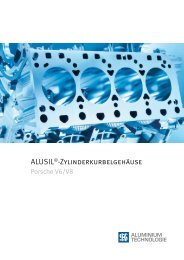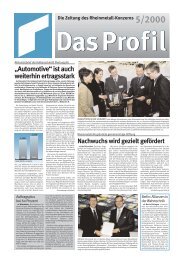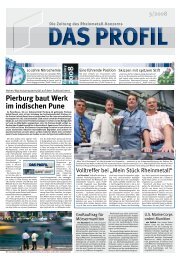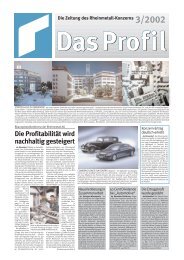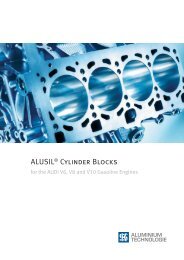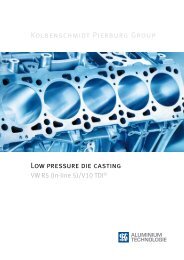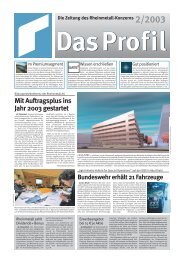PDF [1.1 MB] - KSPG AG
PDF [1.1 MB] - KSPG AG
PDF [1.1 MB] - KSPG AG
Create successful ePaper yourself
Turn your PDF publications into a flip-book with our unique Google optimized e-Paper software.
Newsline<br />
Kolbenschmidt Pierburg in the new Allroader from the German car manufacturer<br />
Engine block and intake<br />
manifold for Audi Q7<br />
Ingolstadt/Düsseldorf. The booming<br />
market for Sport Utility Vehicles (SUVs)<br />
demands a high seat position, good<br />
overview, sturdy appearance and representative<br />
dimensions, all of which<br />
the Audi Allroad Quattro can only fulfill<br />
to a limited degree although it still offers<br />
a good mix between on and off<br />
road capabilities. Audi has now decided<br />
to venture onto the highly competitive<br />
SUV market with a new model. Series-production<br />
of the Audi Q7 that is<br />
based on a study of the Pikes Peak<br />
Quattro will probably be launched in<br />
early 2006. It will initially be available<br />
in two engine variants: a diesel V6-TDI<br />
engine and the 4.2 liter V8 FSI gasoline<br />
direct injection engine.<br />
The engine block for the V8 drive<br />
with bedplate concept will be supplied<br />
by KS Aluminium Technologie <strong>AG</strong><br />
(AT<strong>AG</strong>). The engine block of the V8 engine<br />
will be cast from a hypereutectic<br />
aluminum-silicon alloy known under<br />
its tradename ALUSIL®, a material offering<br />
numerous advantages. The<br />
monolithic, linerless concept allows<br />
an extremely compact design with<br />
minimal bridge width of only 5.5 mm<br />
between the cylinders, allowing low<br />
weight and high integration. This concept<br />
is also distinguished by the optimum<br />
thermal conduction properties<br />
which permit high specific engine performance<br />
characteristics. The non-armored<br />
cylinder bore surfaces are extremely<br />
resistant to seizure, and the<br />
pistons and piston rings run on hard<br />
silicon crystals.<br />
The low pressure die-cast engine<br />
block guarantees a uniform deposit of<br />
silicon crystals in the cylinder bore surface<br />
combined with minimal porosity.<br />
Besides the controlled, low-turbulence<br />
mold filling process, the directional solidification<br />
is also noteworthy. The<br />
casting process allows the introduction<br />
of sand cores, so that structurally stiff<br />
engine blocks are manufactured in a<br />
closed deck design as for the V8 engine.<br />
Another advantage derived from<br />
the low pressure die-casting process is<br />
the unlimited heat treatment of the<br />
casting, permitting not only greater<br />
hardness and higher strength, but also<br />
volume stabilization.<br />
The mechanical “uncovering” of silicon<br />
grains is just one of the outstanding<br />
features of the V8 FSI engine bock. The<br />
process employed by Audi is very similar<br />
to the AT<strong>AG</strong>-patented Siplamec honing<br />
method. This process consists of three<br />
phases: pre-honing, basic honing and<br />
finish-honing, the third step being determining.<br />
The desired surface structure<br />
is obtained by using elastic honing<br />
stones, which – due to the resilience of<br />
the cutting grains – remove more Al-matrix<br />
than Si-grain at the hard cutting<br />
grains. The Si-grains protrude slightly<br />
from the Al-matrix contrary to chemical<br />
process with rounded edges. This reduces<br />
the risk of splinters and also decreases<br />
piston ring wear susceptibility.<br />
11<br />
Yet not just the technology as such<br />
but also the time needed to develop<br />
the engine block for the new Audi Allroad<br />
V8 engine has set new standards.<br />
The simultaneous engineering process<br />
adopted by Audi, AT<strong>AG</strong> and the tool<br />
manufacturer made it possible to reduce<br />
the development time very considerably,<br />
backed by the benefits of virtual<br />
product development.<br />
A further technical highlight of the<br />
Audi Q7 is the new 2-length magnesium<br />
intake manifold from Pierburg<br />
GmbH. The longitudinal actuating<br />
flaps and tumble plates of this intake<br />
manifold are driven by the EAM-b electrical<br />
adjusters developed by Pierburg.<br />
Vacuum-pressure actuators are therefore<br />
not needed so that the intake<br />
manifold can switch independent of<br />
the vacuum supply. To achieve optimum<br />
torque values over a larger speed<br />
range, the intake manifold installed in<br />
Kolbenschmidt supplies the engine block, Pierburg the advanced 2-length intake manifold: the new Audi Q7 Allroader.<br />
the Audi Q7 has two lengths – irrespective<br />
of the engine speed: a short<br />
intake length assures good performance<br />
in the upper speed range and a<br />
longer intake distance permits optimum<br />
torque behavior at medium<br />
speeds.<br />
One general difficulty encountered in<br />
connection with optimum intake manifold<br />
functions is the internal sealing of<br />
the unit. To achieve high torques, Pierburg<br />
has given the manifold maximum<br />
internal sealing properties. This has<br />
been done in three different ways: firstly,<br />
the longitudinal actuating flaps attached<br />
by hot-riveting are sealed with<br />
elastomerics, secondly the welded<br />
tumble plates are pressed-in thus ensuring<br />
good tightness and thirdly, the<br />
channel-shaped magnesium parts are<br />
package-bolted.<br />
Photos (2): Audi


![PDF [1.1 MB] - KSPG AG](https://img.yumpu.com/4218345/11/500x640/pdf-11-mb-kspg-ag.jpg)
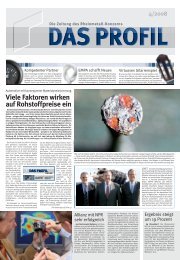
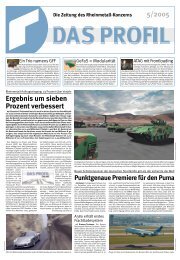
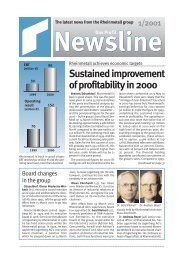

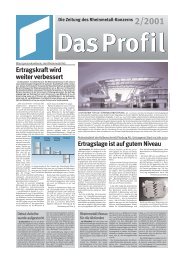
![PDF [1.0 MB] - KSPG AG](https://img.yumpu.com/5513074/1/171x260/pdf-10-mb-kspg-ag.jpg?quality=85)
